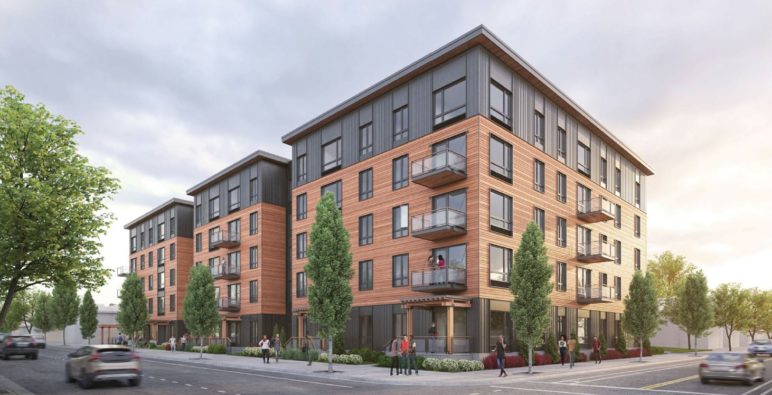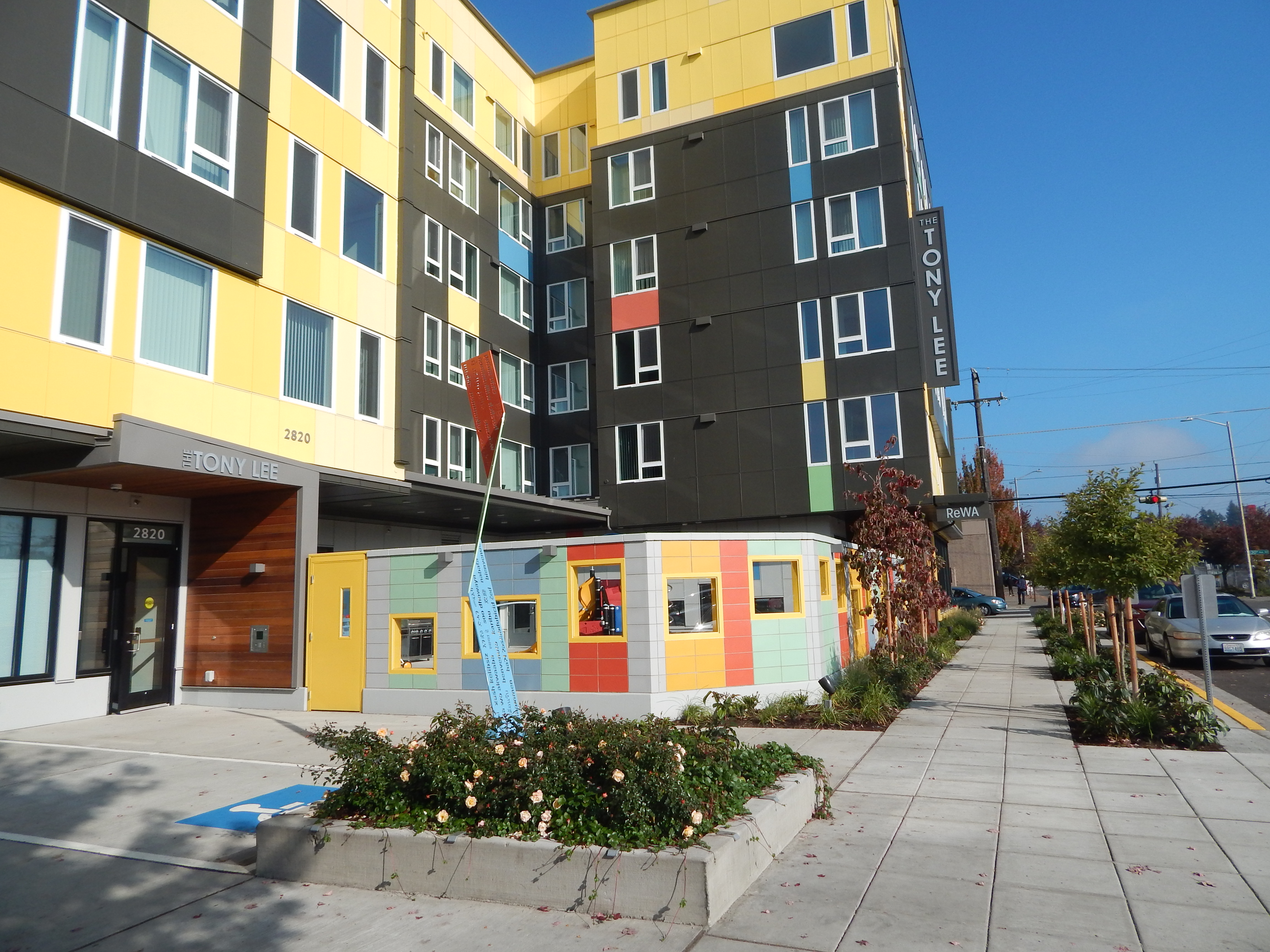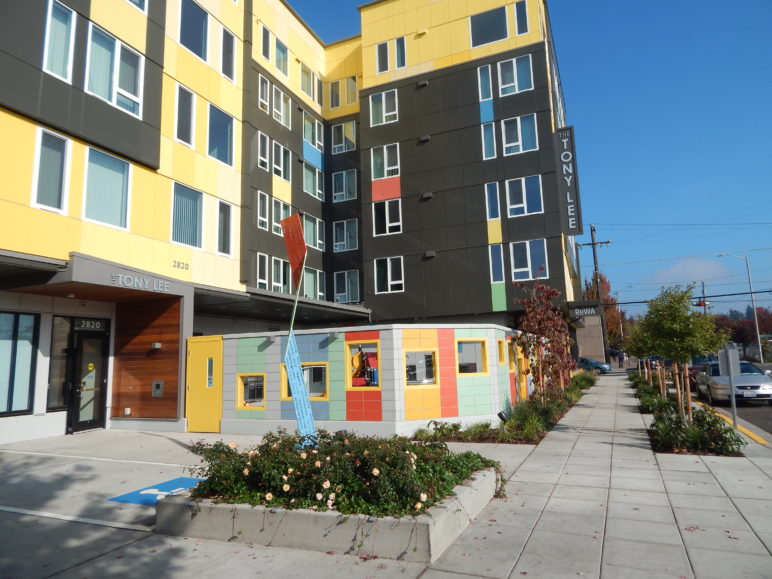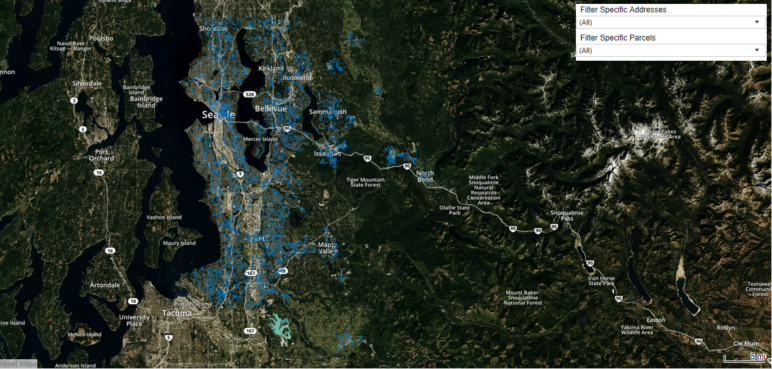As cities across Cascadia look to technological solutions, such as modular construction, to help address the region-wide shortage of affordable housing, one of the biggest factors currently driving up costs is also one of the most resistant to intervention: Land prices, which can add tens of thousands of dollars to the cost of producing a single subsidized apartment.
Cities don’t have a lot of tools for lowering land costs, but they do own a lot of land—Seattle, for example, is sitting on more than 180 excess or underutilized parcels, many of which are well-suited for homebuilding.
To maximize taxpayer value, most cities usually auction off their excess land to the highest bidder, just like any private landowner would do. But in cities with hot real estate markets, affordable housing developers typically don’t have the financial resources to compete for land with market-rate developers. So publicly-owned land ends up in private hands, forever forfeiting its potential to help overcome one of the biggest barriers to the construction of subsidized homes: acquisition of land to build on. The backers of Seattle’s Rainier Valley Food Innovation Hub, for example, have been repeatedly outbid by private developers.
But what if local governments viewed surplus land not as a revenue generator but an opportunity to reduce displacement and stabilize communities? Several Northwest cities have begun asking that very question. The result is a growing string of affordable housing projects stretching through Cascadia—from the largest one-time investment in housing on city-owned land in Canada’s history, to an affordable housing and preschool development on the site of a former fire station in Seattle.
How much publicly owned land is there?
Until recently, if you wanted to know what public land was available in the Seattle area, there was no central database—no way to easily find out, say, if a certain fenced-off plot of land that looked ripe for development was owned by the city or Sound Transit or King County, whether it had the right zoning, and whether it was up for sale. In 2015, newly elected King County Assessor John Arthur Wilson decided to do something about that; he directed his office to create a map of every piece of publicly owned land inside county limits.
The nonprofit Enterprise Community Partners expanded on Wilson’s effort, recently launching the beta version of an interactive tool that allows any interested party to use filters to narrow down a list of about 10,000 developable public properties according to specific characteristics, such as zoning, square footage, and eligibility for tax credits.
“In high-cost cities, it’s really becoming impossible for nonprofits to develop on privately owned land,” James Madden, the Seattle-based senior program director for Enterprise, says. “The average land price, as a percentage of the total cost of development in Seattle, is about 10 to 15 percent, and if land continues to get more expensive, [nonprofits] will be priced out completely. Once you’re paying more than $30,000 a door [for land], it gets very hard for a public agency to justify spending beyond that level on acquisition.” Market-rate developers can charge higher rents to compensate for high land costs—an option not available to affordable housing providers.
Changing the rules that have prevented public land from supporting affordable housing
Wilson, the assessor, says the mapping tools might have been merely informational—a database of public land for sale at prices out of reach for most nonprofit housing builders—if the state hadn’t taken the next step, by giving local governments the authority to sell their land below market value or give it away for free. “We raised this issue with [state House speaker Frank Chopp] last year,” Wilson says. “After we pulled together the list of publicly owned land, we said, ‘Here’s the problem: A lot of this land is owned by agencies that have to sell it for fair market value,” putting even public land out of reach for many nonprofit agencies. In response, Chopp supported, and the legislature passed, a bill allowing state and local agencies to transfer land to affordable housing developers at little or no cost.
Local leaders quickly took notice. Seattle city council freshman Teresa Mosqueda, who campaigned on the need to build more dense, affordable housing, proposed and passed two pieces of legislation this year designed to encourage the city to give away its surplus property for free. The first, which passed in July, made it possible for Seattle’s electric utility, Seattle City Light, to dispose of its excess land at little or no cost—a major departure from its previous policy, which required the utility to sell property at fair market value.
The second, which the council passed unanimously earlier this month, requires the city to consider whether surplus land can be used for affordable housing and, if so, to make it available for that purpose. The legislation also allows the city to hold onto land while a nonprofit housing partner secures financing; directs the city’s Office of Housing to partner with “culturally relevant and historically rooted” nonprofits in areas where residents are at high risk of economic displacement; and mandates that 80 percent of the funds from any outright sale of city property go into one of the city’s affordable housing funds.
“Through smart management of public land, and using surplus and underutilized public land for the best public good, we can reduce the cost of building the affordable housing our communities need,” Mosqueda says. “This will also help us realize more community-led affordable housing and small-business development” by giving housing providers more time to pull together funding and development plans for properties that become available.
Sound Transit’s public land policy starting to bear fruit
The greater Seattle area’s regional transit authority, Sound Transit, has had a similar policy in place since 2016, when a state law went into effect requiring the agency to offer 80 percent of its surplus property to affordable housing providers, and required the winning bidder to make 80 percent of the resulting housing affordable to people making less than 80 percent of the area median income—a policy known as the “80-80-80” rule. The new state law complements that, allowing Sound Transit to also sell its land for below market value or give it away for free to qualifying affordable housing developers.
Already, Sound Transit’s rule change is paying dividends, in the form of two future affordable housing projects. One, in the dense First Hill neighborhood, will be a double rarity: A high-rise affordable housing project (nearly unheard of in Seattle) with 368 units for low- and very low-income seniors and families, built on land that would have cost the nonprofit developers, Bellwether Housing and Plymouth Housing Group, at least $8.6 million (the assessed value) under the old Sound Transit policy. Another project, this one adjacent to the planned Roosevelt light rail station in North Seattle, would build 245 new affordable units, including more than 100 family-size apartments.
Two more Seattle examples: a completed small one and a potential big one
Meanwhile, in the North Seattle neighborhood of Lake City, a new housing and preschool development on the 9,000-square-foot site of an old fire station—the type of small parcel that, in the past, might have been sold to a for-profit developer—just opened its doors. The developer, the Low Income Housing Institute, obtained the land at no cost in what LIHI director Sharon Lee calls “a long and tedious process” that preceded the city’s current policy. Lee anticipates that the new law will make it significantly easier for nonprofits like hers to secure land and move forward with construction faster.
“Right now, we have to find a source of low-cost financing to buy the property and get bridge funding for acquisition if the seller wants a quick purchase,” Lee says. “To the extent that we can have city or county or state property that can be designated for nonprofits [at no cost], I think that will be really, really helpful.” As Seattle’s housing market sizzles on, owners more often demand immediate full payment for land, as opposed to the more traditional option agreement to purchase it later.
Housing advocates see even greater potential in much larger sites—like the city-owned three-acre “Mercer Megablock” in Seattle’s South Lake Union, a neighborhood that is home to the city’s biggest tech companies as well as some of the highest residential rents in the city. The megablock is actually two properties—the so-called megablock or “teardrop” site on Mercer Street, and the Copiers Northwest site on Aurora Ave. N. The city’s recent request for proposals (RFP) seeks the inclusion of at least 175 apartment units rent-restricted for households earning up to 60% of Area Median Income. The site has room for 1,300 homes.
On the open market, the combined megablock property is likely worth in the range of $90 million—indeed, the RFP advertises the land as a rare investment opportunity in a region where rents, and therefore profits, are likely to rise. But because both sites in the combined megablock were purchased, in part, with gas and commercial parking taxes, an estimated 54 percent of the proceeds from the sale or lease of the land must be either spent on transportation purposes or returned to the city’s transportation department, according to Seattle budget director Ben Noble. (The city borrowed a total of $31 million against the Mercer site alone, including $26 million for a nearby road project and $4 million for homelessness-related projects, which must be repaid.) Any land value beyond that could either be discounted to the developer in exchange for provision of affordable homes on site, or used by the city to fund subsidized homes elsewhere.
It remains to be seen how much affordable housing the city will leverage out of the value of the land. Mayor Jenny Durkan recently mentioned the megablock as an example of how the city can “make sure that we’re not just selling the silverware.” She continued: “The number one question about every piece of property that we’re going to sell, trade, or the like… is how can it move us forward on affordable housing.”
Other cities leveraging public land for affordable homes

Rendering of BRIDGE Housing’s N. Williams Center in Portland with 61 affordable housing units. Image by Ankrom Moisan Architects, courtesy of BRIDGE Housing
Outside Seattle, other Cascadian cities are taking steps to keep public land in public hands, and use it to create subsidized homes. In one of the most ambitious recent examples, Vancouver, B.C.’s city council approved a deal with the nonprofit Community Land Trust to build nearly 1,000 units of housing affordable to low- and moderate-income renters on public sites across the city. In a city where the median two-bedroom apartment costs nearly $3,200 Canadian, the larger two- and three-bedroom townhomes will max out at about $2,000, with rent tied to income.
In Tacoma, the city’s redevelopment authority is transferring a piece of land it owns along a future light rail extension, at no cost, to the nonprofit housing provider Mercy Housing Northwest. The project will include 65 apartments affordable to seniors making less than 50 percent of the area median income, and some apartments will be affordable to seniors making less than 30 percent of median. Meanwhile, the Tacoma City Council is working on a new public-land disposition policy and an inventory of publicly owned land, much along the same lines as Seattle’s.
Earlier this month, the city of Spokane—responding, like Seattle, to the state’s new surplus land bill—adopted a new policy allowing city agencies to transfer surplus land at low or no cost for affordable housing. According to the Spokane Spokesman-Review, the city of Spokane owns about half the land in the city. In a statement, Spokane City Council President Ben Stuckart said, “Instead of always determining the value of public property in terms of dollars, let’s also look at it in terms of the number of people we can place on that property in housing they can afford.”
The city of Portland, which has its own online map of city-owned excess and surplus property, has an internal policy that requires city agencies to make surplus property available for sale to the city’s Housing Bureau. This year, the city’s Water Bureau sold three acres of land in North Portland to the Housing Bureau at a below-market price of $3.35 million; the housing agency plans to use the land to build dozens of affordable homeownership units.
Across town in Southeast Portland, according to Housing Bureau spokeswoman Martha Calhoon the city chopped about 10 percent off the cost of a project for low-income seniors and parents adopting kids out of foster care by leasing land from the public schools and offering it to an affordable housing nonprofit, the Native American Youth and Family Center (NAYA), for free. (The project, called NAYA Generations, later drew controversy for reasons unrelated to the lease deal.) And in 2016, Multnomah County agreed to give a one-acre property in North Portland, at no cost, to the California-based nonprofit Bridge Housing Corp., which plans to build 61 units of low- and very-low-income housing on the site—again, according to Calhoon, reducing costs by about 10 percent.
Converting public land into a long-term investment in equitable cities
The concept of giving away public land to support subsidized homes instead of selling it to directly fund government services may be novel for local governments accustomed to thinking of surplus land as a cash cow. But at a time when land prices are increasingly out of reach for even the best-funded nonprofit housing developers, cities can rethink the donation of public land as a broadly assessed tax that has long-lasting public benefits. By trading short-term gain for a long-term investment in affordable homes, cities can support diverse communities and welcome people of all incomes.
In an environment where, as Madden from Enterprise notes, “it’s really becoming impossible for nonprofits to develop on privately owned land,” using the value of public land to subsidize housing looks increasingly like a wise investment.











Ron Parks
This seems like it could be a really good idea, but I don’t really know. It seems a reasonable counterfactual would be to ask how much good could be done by selling off these pieces of land at market rate and then using the money to fund priorities (e.g. homelessness). I am not convinced which alternative is best. This article seems to be assuming this is a good idea without really working through the costs and benefits.
Jeff Smith
Thanks for looking at the land. That’s not easy for moderns but it is crucial. First, technically, land has zero cost, since no person created it. What value it does have is rent–capitalized when price and socialized when public revenue. You said there’s not much government can do about capitalized rents. However, at its disposal are many fiscal tools. Government can recover land value (“recover” because it is the presence of society that generates it) via tax, fee, lease, dues, shift the property tax off buildings onto locations, etc. In jurisdictions that cap the tax rate, you can often skirt that restriction by earmarking the raised revenue for a special purpose as does an assessment district or betterment district. Keep the revenue out of the general fund and use it to pay, say, a housing voucher or residential dividend or, as above, some public housing. It worked in Aspen CO, in Singapore, et al. The special purpose is needed not just to sidestep tax law but this dividend is needed also to win politically. The carrot–promise of money in the pocket–is what makes the stick (land dues) palatable.